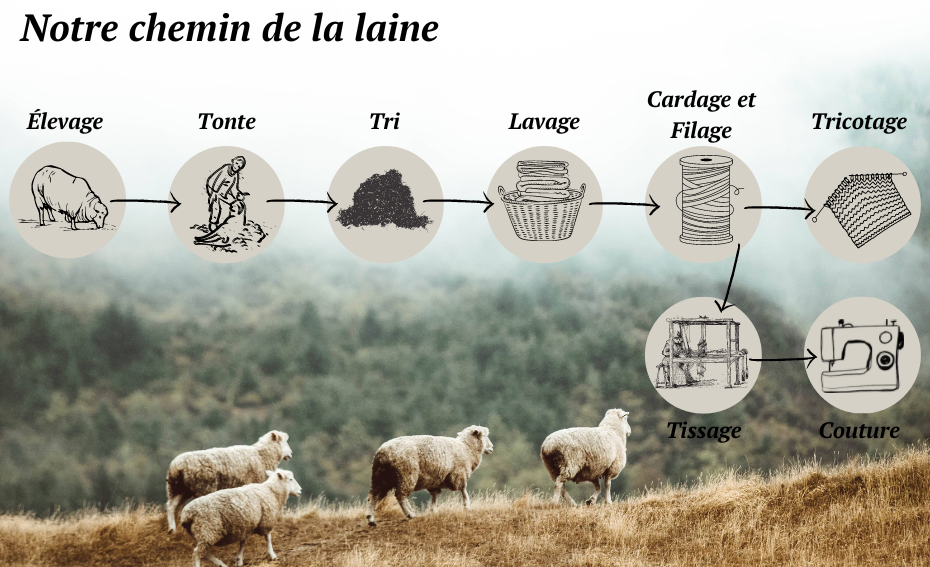Pyrenean wool, what is it ?
Pyrenean wool, what is it ?

And yet, this story remains unknown, as well as the breeds producing this wool as well as and qualities and virtues of this wool.
As an actor of the valorization of this local wool and militant for a revival of the French wool industry, we wanted to plunge you into the world of the Pyrenean wool, this exceptional French wool, with a rich past and bright future, which we have been making you discover for more than 5 years now through our collections of wool clothing and accessories .
So we take the plunge?
Pyrenean wool: one of the ancient economic lungs of the region
It is an understatement to say that the wool of the Pyrenees was a real treasure of the Pyrenees for many decades.
However, it is difficult to give it an exact and definitive origin, so much the wool of the Pyrenees has crossed the ages (we even find trace of its use more than 3000 years ago!).
It is moreover tiresome to quote only one breed of sheep (there were more than twenty!) supplying this white gold as there have been so many species that have given rise to crossbreeding leading to the improvement of the qualities of the wool to obtain long, warm and robust fibers.
As far as the species are concerned, there is one, that you all know, that has particularly participated in the development of the pyrenean wool: the merinos.

Indeed, the merino, of Iberian origin, was introduced in France in 1786 by Louis XVI, in a context of "Sheep War", term introduced by the exhibition of the same name which took place from December 15, 2021, to April 18, 2022. For hundreds of years, the fleece of this breed of sheep was particularly sought after by all European countries, especially the United Kingdom. It is finally France which wins, at first, the arm wrestling and which develops, thanks to La Bergerie de Rambouillet, the breeding of merino sheep. Unfortunately, due to international competition, the French merinos industry fell sharply to the benefit of Oceania.
Let's go back to our pyrenean wool. Ideal for making durable , warm and resistant clothing, pyrenean wool was often associated with flax, a plant that was widely spread in the central Pyrenees and hemp, another plant well known to lovers of breathable clothing...
Each sheep producing between 2 and 8 kg of wool per year, so breeders had relatively large reserves of wool that they used to make their own shepherd's clothing (capes, coats, pants, socks) or even mattresses.
Gradually, thanks to a growing demand and its inherent qualities, this local resource began to be sold, especially in markets, by shepherds' families, which marked its entry point into the pyrenean economy.
It was only at the beginning of the 19th century that the activity accelerated its industrialization, driven by the desire of breeders to provide a source of income to complement their activity. Then, the first industrial basins were created, in particular, in the pyrenean Piedmont.
Consequently, the local wool industry developed, created many jobs and even began to go global, particularly in Europe, to become one of the economic lungs of the Pyrenees. Allowing the manufacture of high quality fabrics, pyrenean wool became more and more sought after until the 20th century.
From the rise to the fall
Unfortunately, during the 20th century, the wool of the Pyrenees gradually lost its influence and attractiveness. The reasons are numerous such as:
- The first reason is the development of globalization, and the arrival of synthetic fibers, much less expensive than French wool. The use of these new fibers is soaring and is gradually leading to the dislike of more natural fibers such as wool, linen or hemp.
- The second is a consequence of the first one. Indeed, the arrival of synthetic fibers brought a profound change in consumer habits in terms of clothing. There are two reasons for this: the final price of these new garments, less expensive than standard wool garments, and the development of fast fashion and the "trend" system requiring easily and quickly exploitable materials to quickly create new garments.
- The third one is linked to the competitiveness of French wool compared to foreign wool, which is less expensive and has characteristics similar to local wool. We can, for instance, quote the merino wool from New Zealand or Australia, producers of more than 33% of the world's wool. This lack of competitiveness has led to a sharp drop in the demand for Pyrenean wool, leading to a significant drop in the price of wool, so much so that the sale price no longer covers the price of shearing for breeders.
A final phenomenon, more recent this time and which concerned all of us, completed the fall in the price and quantities sold of pyrenean wool: the Covid-19 crisis. This crisis has led, following the closing of the borders, to the stop of the importation of French wool by its main importer: China.
What about now ?
Today, the resistance is getting organized, and the wool of the Pyrenees is gradually beginning regaining its attractiveness at the national and international level, supported by projects and initiatives such as the projects of categorization, valorization and sorting of wool carried out by companies (Marelha, Laines Paysannes, Agence des Pyrénées, etc.), collectives (Collectif Tricolor) or institutions (ACAP, New Aquitaine and Occitanie regions, departments and cities).The work of these actors invested in the valorization of the wool of the Pyrenees allows us to share with you this short presentation.Unfortunately, these many decades of abandonment of wool from the Pyrenees for the textile sector have led to the appearance of new problems, limiting the development of the local wool sector:
- The breeders, for lack of demand, were forced to throw away or even burn the wool, wool having become a constraint , more than a resource.
- The pyrenean wool has become rustic and has lost some of its softness, notably because of the difficulty in mapping the different breeds producing this wool. Each wool-producing breed has its own characteristics and qualities as well as its own grazing territories and breeding systems, so sorting the wool has become an essential step in recovering a wool suitable for each trade. However, due to a lack of actors, this essential step in the redevelopment of Pyrenean wool has come to a slight halt and is only carried out by a handful of actors.
Fortunately, alternatives do exist. At Maison Izard, to find a local wool with the qualities and virtues of yesteryear, we mix Pyrenean wool with recycled materials to find the extreme softness, durability and breathability that characterized it.
Overview of current breeds:

Thanks to the work of the above-mentioned actors, a first mapping of the breeds bred on the whole French Pyrenean slope is under study, thanks to a consultation with the breeders. Here are the first results in terms of breeding departments of the different breeds present on the French Pyrenean side:
- Pyrénées-Atlantiques breeds : Basco-Béarnaise, Berrichon, Charollais, Lacaune Manech Tête Rousse and Manech Tête Noire, Merinos, Romanesque, Suffolk, Tarasconnaise.
- Hautes-Pyrénées breeds : Aure and Campan, Barégeoise, Ile-de-France, Lourdaise, Merino, Mouton de l'Ouessant.
- Haute-Garonne breeds : Charmoise, Mouton de l'Ouessant, Suffolk.
- Ariège breeds : Castillonaise, Charmoise, Lacaune, Merino, Montagne Noire, Scottish Blackface, Tarasconnaise.
- Aude breeds : Blanche du Massif Central, Rouge du Roussillon.
- Pyrénées-Orientales breeds : Blanche du Massif Central, Caussenarde, Rouge du Roussillon.

- Aure et Campan : resistant, soft and retaining heat very well, this quality wool, fine and rich, is very appreciated for the manufacture of clothing and accessories. It is also from this wool that our French wool plaid is made in collaboration with Pyloow.
- Barégeoise : very fine wool but not very rich. It is an exceptional wool, very robust, used in particular in the clothing industry.
- Basco-Béarnaise : white wool, sometimes tinted with red, with long and pointed fibers. This wool, of average quality and rustic, is currently barely used.
- Ile-de-France : wool with qualities similar to Merino. It is particularly distinguished by its fineness, its flexibility and its softness. Its grease (which represents the fat that the skin and the sheep secrete, and which binds to the wool) is of buttered color, which makes it a very sought after grease.
- Lacaune : short and fine wool, used in particular for the manufacture of insulating wadding (allowing the design of clothing lining or mattresses for instance).
- Lourdaise : white wool, it is made of long strands and is particularly used for the manufacture of clothing and accessories.
- Manech à tête noire : long and thick fibers, the qualities of this rustic wool are numerous : comfortable, resistant and insulating, the wool of this breed of sheep can be used as well for the confection of accessories, mattresses or decoration.
- Tarasconnaise : this white wool, with long fibers, is rather rough and is still little used.
A wool with many qualities
Pyrenean wool has many qualities, which explain the great use it has had for thousands of years.

The first of these qualities is that, as a natural fiber, pyrenean wool is a virtuous and biodegradable material, while being local . Entirely renewable and recyclable, its shearing is also vital for the health of sheep. Because although essential in winter to face the cold of the mountains, the wool becomes a handicap for these animals as soon as the first heats appear. Shearing is then essential to free the animal from this enveloping mass, which can accumulate bacteria and parasites, potentially vectors of diseases and thus harm its health. Its eco-responsible virtues do not stop there since wool is highly durable thanks to its resistance and its elasticity. This aspect allowing it to last much longer than many other fibers, natural or not. 
The virtues of wool do not stop there, it is also an extremely comfortable and practical material. Indeed, thanks to its lightness and softness, it is very easy and pleasant to work with, which allows it to be adapted to a multitude of fields (textiles of course, but also insulation, interior decoration or even bandages and dressings for the medical sector).
Speaking of comfort, you may have already noticed that wool has a special place in the bedding industry. And not for nothing! According to a study conducted by the University of Sydney, wool would help you fall asleep while making your sleep more restful. You will not be surprised to see that many bedding brands use wool to make their mattresses!
Let's continue on the comfortable dimension of wool with two of its most famous characteristics: its breathability and its incredible thermoregulatory faculties. The first is largely due to its semi-permeable fibers that allow it to absorb moisture in large quantities, thus limiting humidity and sweating.
Its thermoregulatory faculties are also important (even more for us, textile professionals!) and very well known. We spontaneously think of wool as a barrier against the cold, but the opposite is also true. Wool is also a great vector of thermal insulation thanks to its wavy texture which allows it to store a large quantity of air and thanks to its scaly structure which will allow it to increase its surface in contact with the air while slowing down its circulation. In short, it will keep the warmth as well as the coolness (that's why merino wool for example is used for technical clothes). Last important point, contrary to what we usually think, wool is very easy to maintain and requires little effort. Almost wrinkle-free thanks to the high degree of elasticity of its fibers, it also attracts little dust and resists greasy stains. It is also a material that likes oxygen and, in contact with it, releases its odors and impurities. Water and electricity consumption is therefore reduced! As far as washing is concerned, although wool does not require regular washing, it can be washed very well in a short or delicate cycle, which makes it much easier to maintain.

Finally, there are qualities and virtues of wool less known by the general public, but which are nevertheless very interesting (for companies as well as for individuals!).
The first is its soundproofing dimension, quality which is conferred to him by its density and its curling. Thus, the sound waves will penetrate inside the material, but will have enormous difficulties to leave it. It can therefore act as a natural insulator for all the rooms in the house!
Its second unknown quality is, like plants, its ability to purify the air thanks to its molecular structure. Wool is therefore ideal for purifying the nitrogen dioxide emitted by our domestic appliances or harmful substances such as formaldehyde, a harmful and potentially carcinogenic gas that is frequently present in the equipment, decoration and domestic products in our homes.
Last unknown quality, wool offers natural protection againt UV, protection that is even superior to natural fibers such as cotton or many synthetic fibers commonly used for the design of technical clothing.
All its qualities and virtues make this local resource a formidable vector of economic growth for the territories in which Pyrenean wool is available in quantity. In the long term, the use of this local wool aims to develop many structures on all the links of the chain: breeders, washing stations, spinning mills, knitting workshops, material laboratories and of course, companies.
New uses and actors
In this valorization of the wool, there is still a link in the chain that we have not discussed much: the companies .
The possible uses of the pyrenean wool by the companies are vast (and will even tend to uses that we have not yet thought of, so much the qualities of this resource are multiple).
Here are some examples:

Source: Mag'in France
As illustrated by this infographic, Pyrenean wool has (almost) a thousand and one uses, in many different trades.Looking for some brands using this local wool?
Here are some of our favorite Pyrenean brands:
- Traille, who created, in cooperation with the European Center for Innovative Textiles (CETI), a wool wadding used to stuff clothes.
- Pyloow, Pyrenean brand of decorative accessories offering plaids, cushions and poufs. Does the name mean anything to you? It's normal, it's in collaboration with this beautiful brand that we offered our very first French wool plaid.
- Armaité, brand from the Basque Country that has been making espadrilles for 3 generations. Wool from the Pyrenees is used to make its winter espadrilles
- Laulhère, historical brand of berets, established near the Pyrenees for over a hundred years. The brand offers timeless and authentic headwear made of natural materials such as linen, cashmere or wool, notably from the Pyrenees.
- Laines Paysannes , French brand of clothing and accessories committed to the revalorization of Ariège wools through a sustainable, mixed and authentic wardrobe.
At Maison Izard, strongly attached to our territory and its specificities, we made the choice to develop this exceptional local raw material by designing, in an ethical and responsible way, sweaters and accessories made of Pyrenean wool! The valorization of this exceptional resource allows us to create eco-responsible, durable, comfortable and breathable products.
Each year, we enlarge or perfect our range, always from Pyrenean wool, to offer you a timeless, mixed and authentic wardrobe.
We hope that this overview of the wool of the Pyrenees will have interested you and will have made you discover the numerous richnesses of this exceptional local wool as well as the actors who revitalize, every day, the local wool industry!
PS : This article was written by hand, by a human, and not by ChatGPT.



